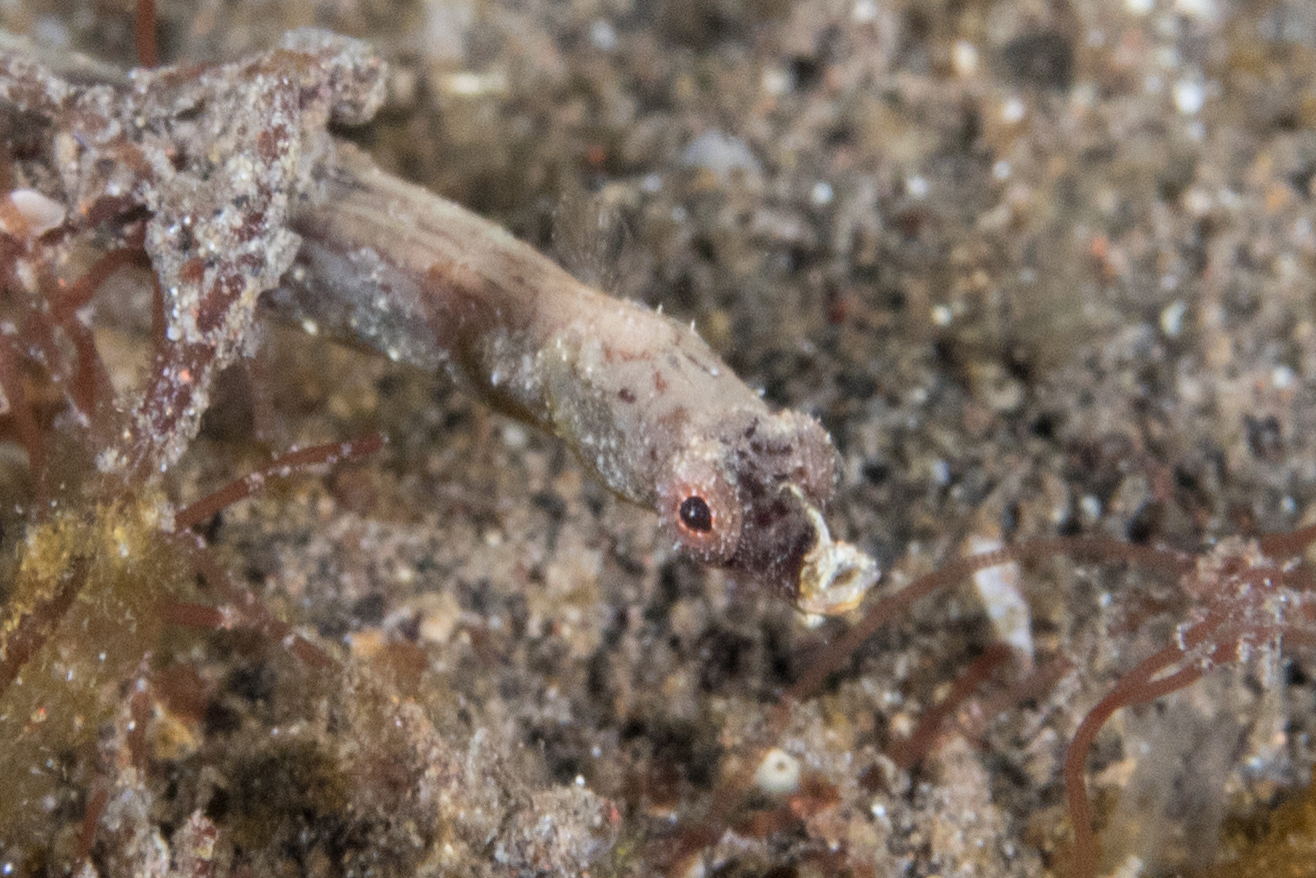Anderson's Pipefish, Micrognathus andersonii (Bleeker 1858)

Anderson's Pipefish, Micrognathus andersonii, at Karang Asem, Bali, Indonesia, August 2015. Source: Mark Rosenstein / iNaturalist.org. License: CC by Attribution-NonCommercial-ShareAlike
A small brownish pipefish with small, dark-edged pale bars along the back and upper sides. This tiny, slender pipefish has a very short snout and tiny skin flaps mostly on the head.
Anderson's Pipefish, Micrognathus andersonii (Bleeker 1858)
More Info
|
Distribution |
Tropical Indo-West Pacific from the Red Sea and East Africa, eastwards across the Indian Ocean to Tonga, southern Japan and northern Australia, from Cape Melville to about Southport, Queensland; also Cocos (Keeling) Islands. Inhabits crevices, along with rubble and weed areas on coastal reefs. |
|
Features |
Meristics: D 17-24; A 3; P 11-13; trunk rings 15-17; tail rings 27-32; subdorsal rings 1.75-0.25 + 2.5-5.0 = 3.75-5.75. Head and body: Body encased in bony rings, slender, elongate; snout short, 2.7-3.4 in head length; snout depth 1.6-2.8 in snout length; superior trunk and tail ridges discontinuous; inferior trunk ridge ends on anal ring; lateral trunk ridge continuous with inferior tail ridge; median dorsal snout ridge low, entire, somewhat concave in lateral profile; longitudinal opercular ridge complete in young, incomplete to obsolete in subadults-adults; head and body rings without spines, denticules or serrations; scutella not keeled; lateral line absent. Fins: Dorsal fin originates between anterior margin of second last trunk ring and posterior margin of 1st tail ring, the fin base not clearly elevated in subadults-adults. |
|
Size |
To 6 cm |
|
Colour |
Pale to dark brown, plain, mottled or blotched, usually with white saddles across the back. |
|
Feeding |
Likely to feed on small crustaceans. |
|
Biology |
Reproduction: Ovoviviparous (gives birth to live young) with males brooding the eggs in a brood pouch under the tail. The pouch has pouch plates and folds, and an everted pouch closure. Males may be brood eggs by about 35 mm SL, and incubate about 95-100 eggs. Eggs: Planktonic, not described. Larvae: Planktonic, body rings are present at an early age, and the anal fin is reduced. Larvae have been collected in the upper 100 metres over very deep water. |
|
Fisheries |
Of no interest to fisheries or aquaculture. |
|
Conservation |
Australian Government Legislation: Marine listed under the Environment Protection and Biodiversity Conservation Act 1999 (EPBC Act) and subject to the export controls of the Commonwealth Wildlife Protection (Regulation of Exports and Imports) Act 1982. CITES: Not listed. IUCN: Not evaluated. |
|
Remarks |
The species appears to vary geographically in morphology, and may form a species complex. |
|
Similar Species |
A combination of 16 trunk rings modally, usually 18-22 dorsal fin rays, a short snout and essentially straight tail ridges, distinguishes M. andersonii from other species in the genus. Adult males also tend to have more brood-pouch rings than other species in the genus. |
|
Etymology |
Micrognathus is from the Greek micro meaning small and gnathus meaning jaw. |
|
Species Citation |
Syngnathus andersonii Bleeker 1858, Nat. Tijdschr. Ned. Ind. 15: 465, Cocos Keeling islands, Eastern Indian Ocean. |
|
Author |
Dianne J. Bray & Vanessa J. Thompson |
Anderson's Pipefish, Micrognathus andersonii (Bleeker 1858)
References
Dawson, C.E. 1982. Review of the genus Micrognathus Duncker (Pisces: Syngnathidae) with description of M. natans, n. sp. Proc. Biol. Soc. Wash. 94(3): 657-687.
Dawson, C.E. 1985. Indo-Pacific Pipefishes (Red Sea to the Americas). Gulf Coast Research Laboratory, Ocean Springs, Mississippi. 230 pp.
Dawson, C.E. 1986. Family No. 145: Syngnathidae. pp. 445-458. In Smith M.M. & P.C. Heemstra (eds.) Smiths' sea fishes. Macmillan, Johannesburg South Africa.
Kuiter, R.H. 2009. Seahorses and their relatives. Aquatic Photographics, Seaford, Australia.
Kuiter, R.H. & T. Tonozuka. 2001. Pictorial guide to Indonesian reef fishes. Part 1. Eels- Snappers, Muraenidae - Lutjanidae. Zoonetics, Australia. 302 pp.
Myers, R.F. 1999. Micronesian reef fishes: a comprehensive guide to the coral reef fishes of Micronesia. 3rd revised and expanded edition. Coral Graphics, Barrigada, Guam. 330 pp.
Nakabo, T. 2002. (ed.) Fishes of Japan with pictorial keys to the species. English edition. Tokai University Press. vol. 1, 866 pp.
Paulus, T. 1999. Family Syngnathidae. pp 2264-2276. In Capenter K.E. & V.H. Niem (eds.) The Living Marine Resources of the Western Central Pacific. FAO Species Identification Guide For Fisheries Purposes. FAO Vol. 4. pp 2069-2790.
Paxton, J.R., J.E. Gates, D.F. Hoese & D.J. Bray. 2006. Syngnathidae. In Beesley, P.L. & A. Wells (eds). Zoological catalogue of Australia. Volume 35. ABRS & CSIRO Publishing: Australia. 2178 pp.
Pogonoski, J.J. Pollard, D.A. & Paxton, J.R. 2002. Conservation Overview and Action Plan for Australian Threatened and Potentially Threatened Marine and Estuarine Fishes. Canberra Environment Australia 375 pp.
Randall, J. E. 2005. Reef and shore fishes of the South Pacific. New Caledonia to Tahiti and the Pitcairn Islands.
Randall J.E., Allen G.R. & Steene R. 1997. Fishes of the Great Barrier Reef and Coral Sea. Crawford House Press, Bathurst 2nd Edn, 557 pp.





